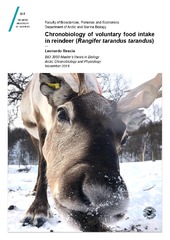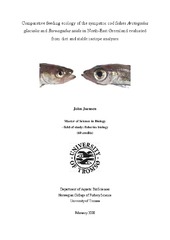Blar i tittel Mastergradsoppgaver i biologi
Viser treff 51-70 av 357
-
Characterizing movement and searching behavior of humpback whales at the North-Norwegian coast
(Master thesis; Mastergradsoppgave, 2022-05-16)Studying movement patterns of individual animals over time can give insight into how they interact with the environment and optimize their foraging strategies. Humpback whales (Megaptera novaeangliae) undertake long seasonal migrations between feeding areas in polar regions during summer/early winter and breeding areas in more tropical areas during late winter/spring. The Norwegian Sea is a part of ... -
Chronobiology of voluntary food intake in reindeer (Rangifer tarandus tarandus)
(Master thesis; Mastergradsoppgave, 2018-11-15)In all organisms, biological rhythms arise from the interaction between endogenous clocks and a rhythmic environment. The timing of sunrise and sunset synchronize internal timing processes and inform the organism not only of the time of day, but also of the time of year. For animals living in polar regions biological timekeeping represents a challenge, given that the sun does not rise during the ... -
Circadian disruption by light and its effect on the immune function of the Atlantic salmon (Salmo salar)
(Master thesis; Mastergradsoppgave, 2022-05-16)The Atlantic salmon (Salmo salar) is an anadromous salmonid that begins its life cycle in freshwater streams then, develops, in a process known as smoltification, into a marine-adapted fish prior to its migration to the sea. Smoltification is a photoperiod regulated process which involves extensive change in the salmons’ physiology. In recent years smoltification procedures in aquaculture has been ... -
Circannual rhythms in Arctic charr (Salvelinus alpinus)
(Master thesis; Mastergradsoppgave, 2023-05-15)The Arctic charr (Salvelinus alpinus) is a true arctic species and is considered to be the northernmost freshwater fish. Since this species is being known for its great variability in size, phenotype, colour, ecology and history, some of them are landlocked (which stay in freshwater all their life) and others are anadromous (they undertake summer migrations to sea and then they come back to ... -
Climate-induced range expansions of marine fauna into the Arctic – what is the most likely colonisation route?
(Master thesis; Mastergradsoppgave, 2018-05-14)As a result of climate change, the Arctic faunas of the Northeast Atlantic have begun to shift in an Atlantic direction. One system exposed to such a change is the Northeast Greenland (NEG) Shelf. However, the colonisation route taken by boreal fauna to the NEG shelf is unknown. This knowledge is essential to predict to what extent boreal fauna will dominate Arctic habitats, and alter ecosystems in ... -
Comparative effects of two temperatures (0 & 3 °C) on Polar cod embryonic and larval development
(Master thesis; Mastergradsoppgave, 2019-11-14)Polar cod (Boreogadus saida) are particularly vulnerable to climate change. Increasing our knowledge of polar cod development will help improve our understanding of the impact of climate change and the impacts this might have on the population. This study aimed at characterizing the development of Polar cod from fertilisation to 86 days post fertilisation (dpf) at two temperatures within their ... -
Comparative feeding ecology of the sympatric cod fishes Arctogadus glacialis and Boreogadus saida in North East Greenland evaluated from diet and stable isotope analyses
(Master thesis; Mastergradsoppgave, 2008-02-15)The fish fauna was investigated in autumn 2003 during the TUNU-I Expedition to NE Greenland fjords. Two gadoids Arctogadus glacialis and Boreogadus saida were abundant in many trawl hauls. In this study, the stomach contents and the stable isotope composition were determined in 60 Arctogadus glacialis and 50 Boreogadus saida from Tyrolerfjord and Dove Bugt. The diets were examined by Stomach Contents ... -
Comparing seed carrier transfer ratios for start-up of moving bed biofilter reactors in recirculating aquaculture systems (RAS)
(Master thesis; Mastergradsoppgave, 2023-06-05)Optimizing and documenting use of inoculation and seeding ratios for RAS start-up. -
Comparison of eyfluke (Diplostomum spp.) infections of polymorphic whitefish (Coregonus lavaretus L.) populations in two sub-Arctic Norwegian lakes
(Master thesis; Mastergradsoppgave, 2018-08-15)Abstract Parasites might be small, but they are very important elements in the ecosystems. Parasites may have a strong negative influence on their host, and some species might even manipulate their hosts. Parasites commonly have complex life cycles and may use multiple different hosts. This study has been conducted in two sub-arctic lakes in Northern Norway with polymorphic whitefish populations. ... -
Comparison of gillnet and trap in relation to retention of salmon lice (Lepeophtheirus salmonis), size selection of sea trout (Salmo trutta) and catch efficiency
(Master thesis; Mastergradsoppgave, 2016-05-15)Salmon lice (Lepeophtheirus salmonis) are marine ectoparasites commonly found on salmonid species, where the infection levels on wild salmonids have dramatically increased the latest decade. Sea trout (Salmo trutta) is being used in salmon lice monitoring studies (e.g. NALO) where different sampling gears are used. The interaction between sea trout and lice is complicated, and therefore methodology ... -
Contrasting body burdens of organohalogenated contaminants in two Arctic glaucous gull Larus hyperboreus populations in relation to their dietary ecology
(Master thesis; Mastergradsoppgave, 2021-06-12)This study compared body burdens of organohalogenated contaminants (OHCs) between glaucous gull populations from Bjørnøya and Kongsfjorden, Svalbard and if OHC levels was influenced by their dietary ecology and biological variables (body condition index and sex). To do so, blood from 112 adult glaucous gulls were sampled during the breeding seasons of 2015 until 2019 in Bjørnøya and Kongsfjorden. ... -
Contrasting patterns in trophic niche evolution of polymorphic Arctic charr Salvelinus alpinus L. populations in two subarctic lakes, northern Norway
(Master thesis; Mastergradsoppgave, 2018-05-15)The trophic niche (recent and time-integrated niche estimates) of polymorphic populations of Arctic charr was investigated in two lakes in Northern Norway. The lakes, Tårnvatn and Skøvatn, have three and two morphs, respectively. Since the two systems are very similar in environmental conditions and fish communities, comparable niches between similar trophic morphs across lakes were expected caused ... -
Coping with change: The role of environmental parameters for Calanus lipid storage in Northeast Greenland fjords
(Master thesis; Mastergradsoppgave, 2023-08-15)The importance of Calanus in the Arctic pelagic ecosystem is well established in the Norwegian-Arctic region. However, research on Calanus in Northeast Greenland remains limited. Calanus condition and role in the Arctic pelagic ecosystem might be different on the western side of the Fram strait because of influence from the East Greenland current that brings cold and less saline water in from the ... -
Core body temperature cycles in captive Svalbard rock ptarmigan (Lagopus muta hyperborea)
(Master thesis; Mastergradsoppgave, 2016-08-15)The Svalbard rock ptarmigan (Lagopus muta hyperborea) is an arctic animal and lives as such in constant light and constant darkness for parts of the year. They are therefore an interesting subject for chronobiologists and have been thoroughly studied in terms of their biological rhythms. One rhythmic physiological factor, however, has received little attention in former studies: oscillation in core ... -
Corvids response to fluctuating abundance of resources in tundra ecosystems
(Master thesis; Mastergradsoppgave, 2018-05-15)Aim Despite the numerous studies on corvids’ behaviour, their dynamics in different ecosystems is unknown. Ravens and hooded crows are opportunistic generalists acting as both predators and scavengers. Ravens are probably the most specialized scavengers on ungulate carcasses and both species are known as efficient hunters of small rodents. Small rodents are a key species in the tundra as they represent ... -
The cost of parasites – Metazoan parasite community of anadromous Arctic charr (Salvelinus alpinus) from Northern Norway
(Master thesis; Mastergradsoppgave, 2023-05-14)Anadromous salmonids migrating in the marine system to feed are at risk of accumulating trophically transmitted parasites that may have negative effects on the salmonid host. The aim of this study was to explore the metazoan parasite community of returning anadromous Arctic charr (Salvelinus alpinus) directly after entrance to freshwater. This is the first study conducted in Europe looking at the ... -
Cyclic nucleotide dependent ATPase activity in inside out vesicles from human erythrocytes
(Master thesis; Mastergradsoppgave, 2015-01-27)The transport of cyclic nucleotides out of the cell is energy requiring, dependent on ATP- hydrolysis. The ability to stimulate this ATPase is a hallmark of substrates for ABC-transporters e.g. ABCC5, ABCC4. It is believed that ABCC5 transporter has selective high affinity for cGMP. Previous studies support the idea that ABCC5 contribute to cGMP transport by human erythrocytes. Human erythrocyte ... -
Decomposition in differing snow regimes in high Arctic Svalbard
(Master thesis; Mastergradsoppgave, 2019-05-29)Rapidly rising temperatures are having great effects on the high arctic ecosystem, historically characterized by long, cold winter periods, and cold dry summers. Due to the length of the winter season, arctic soils have been an important carbon sink, but may now be facing increased microbial activity due to increasing temperatures. Temperature, moisture, and litter quality play important roles in ... -
The Demersal Fish Community on the West Spitsbergen Shelf. Biodiversity, species composition, distribution and temporal changes in relation to climate.
(Master thesis; Mastergradsoppgave, 2020-05-29)This thesis explores a historical time series of trawl stations on the West Spitsbergen Shelf (WSS), aiming to understand the spatial and temporal variability of the demersal fish communities in the region. Abundance data of 42 fish species are used to investigate the species composition, richness, and diversity across six different areas under different environmetal influence. The results indicate ... -
Demographic patterns in winter carcass use by Golden Eagle and White-tailed Eagle in Finnmark, Norway
(Master thesis; Mastergradsoppgave, 2012-02)The carcass use of juveniles, subadults and adults of the two eagle species in Norway, the White-tailed Eagle (Haliaeetus albicilla) and the Golden Eagle (Aquila chrysaetos) was studied in Finnmark, the northernmost county of Norway for two winters, in 2009 and 2010. Artificial carrion was laid out as bait on four peninsulas, along with automatic digital cameras which took picture on 5-15 minutes ...


 English
English norsk
norsk


















